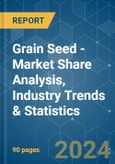The Grain Seed Market size is estimated at USD 41.14 billion in 2024, and is expected to reach USD 55.99 billion by 2030, growing at a CAGR of 5.27% during the forecast period (2024-2030).
Key Highlights
- Corn is the Largest Crop: The increase in the demand for corn is due to the high-value crop, high Return on Investment, and increase in the demand by the lubricants industry for biofuel production.
- United States is the Largest Country: The country is the second-largest producer of grains globally with corn and wheat being the major contributors. The country is the leading producer of biofuel globally.
- Sorghum is the Fastest-growing Crop: The market expansion for sorghum seeds is driven by the crop's ability to adapt to changing weather conditions, and an increase in the demand for animal feed by dairy farmers.
- Ukraine is the Fastest-growing Country: Ukraine witnessed the fastest growth because it is the largest producer of wheat in Europe and the adoption of hybrid seeds led to increase in the export of grains to Africa.
Grain Seed Market Trends
Hybrids is the largest Breeding Technology
- Globally, hybrids hold a major share of the global grain seed market in terms of value. Under hybrids, transgenic crops hold a share of 46.9% in terms of value. Asia-Pacific has the largest non-transgenic grain seed market, with a market share of 50.3% in terms of value. Among grains, only corn and rice herbicide-tolerant seeds for cultivation are approved.
- The share value of GM herbicide-tolerant grains is expected to grow by 28% from 2021 to 2028 due to the increased use of GM herbicide-tolerant varieties. The share value of GM insecticide-resistance grains is expected to increase by 34.2% from 2021 to 2028 due to the increased use of GM insecticide-resistant varieties.
- In the grain seed market, the other traits crops hold a share of 5.8% of the total transgenic crops. The major other traits include stress tolerance, drought tolerance, water-lodging tolerance, disease resistance, etc.
- Globally, the open-pollinated varieties and hybrid derivatives accounted for 31.3% of the total grains and cereals seed market in 2021. Asia-Pacific was the largest consumer of open-pollinated varieties and hybrid derivatives for the cultivation of grains and cereals. The region accounts for 39.2% of the global grains and cereals OPVs seed market.
- The companies are heavily investing the new plant technologies due to the increasing demand for advanced improved varieties that are adaptable to different climatic conditions, have high yield potential, are resistant to diseases, and are drought tolerant. In 2020, Bayer opened there first fully automated greenhouse in Marana, Arizona, which includes innovation advancements in proprietary seed chipping, advanced marker technology, automation, and data science.
North America is the largest Region
- Globally, North America has the largest grain seed market, accounting for 41% of the global grain seed market in terms of value. The area under grains and cereals in North America was 57.6 million hectares in 2021, which increased by 8.7% since 2016 due to an increase in the processing facilities and governments pushing for the adoption of grains for self-sufficiency as grains and cereals are the staple food in the diet.
- In Asia-Pacific, China has the largest grain seed market, and it accounted for 21.7% of the global grain seed market and 63.7% of the Asia-Pacific grain seed market in terms of value in 2021. China is self-sufficient in rice and wheat and nearly self-sufficient in corn seed.
- In Europe, the grain seed segment was the major contributor to the overall seed market. It contributes 49% to the Europe seed market in terms of value. The region is a major producer of corn, with a share value of 10% in the global corn seed market. France is the leading producer of corn. Spain, Italy, and Turkey are the major producers of wheat in Europe, accounting for 12% of the global wheat seed market.
- In 2022, South America had a market share of about 9.7% in the global grains seed market. Brazil is the third-largest producer of corn globally, with the availability of improved seed varieties for higher yield as well as resistance to diseases.
- The increased animal production and meat demand, the increased processing facilities, and increased organic farming practices are driving seed companies to develop seeds for different types of growers. The consistent demand by food industries is expected to boost the global grains seed market during the forecast period, registering a CAGR of 4.3%.
Grain Seed Industry Overview
The Grain Seed Market is fragmented, with the top five companies occupying 37.65%. The major players in this market are Advanta Seeds - UPL, Bayer AG, Corteva Agriscience, KWS SAAT SE & Co. KGaA and Syngenta Group (sorted alphabetically).Additional Benefits:
- The market estimate (ME) sheet in Excel format
- 3 months of analyst support
Table of Contents
1 EXECUTIVE SUMMARY & KEY FINDINGS2 REPORT OFFERS7 KEY STRATEGIC QUESTIONS FOR SEEDS CEOS
3 INTRODUCTION
4 KEY INDUSTRY TRENDS
5 MARKET SEGMENTATION
6 COMPETITIVE LANDSCAPE
8 APPENDIX
Companies Mentioned (Partial List)
A selection of companies mentioned in this report includes, but is not limited to:
- Advanta Seeds - UPL
- Bayer AG
- Corteva Agriscience
- Florimond Desprez
- Groupe Limagrain
- KWS SAAT SE & Co. KGaA
- RAGT Semences
- S & W Seed Co.
- Syngenta Group
- Yuan Longping High-Tech Agriculture Co., Ltd
Methodology

LOADING...










